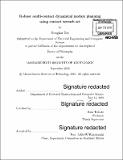Robust multi-contact dynamical motion planning using contact wrench set
Author(s)
Dai, Hongkai, Ph. D. Massachusetts Institute of Technology
DownloadFull printable version (13.70Mb)
Other Contributors
Massachusetts Institute of Technology. Department of Electrical Engineering and Computer Science.
Advisor
Russ Tedrake.
Terms of use
Metadata
Show full item recordAbstract
In this thesis, we seek to plan a robust motion for robot with multiple non-coplanar contact on the environment. When the robot interacts with the environment through contact, it relies on the contact forces to generate the desired acceleration. The contact forces have to satisfy some physical constraints, such as lying within the friction cones. These constraints limit the robot acceleration. The robustness of the motion can be measured as the margin to the boundary of these constraints. By planning motion with a large preserved margin, we enable the robot to withstand large disturbance in the online motion execution. In this thesis, we adopt the notion of contact wrench set to approximate the constraints on the robot dynamics. The margin of such set measures the capability of the motion to perfectly resist external wrench disturbance. We plan robust motion to increase this contact wrench set margin. We present two planners to improve this robustness metric. For the first simple-model planner, we pre-specify the contact locations, and it generates a Center of Mass trajectory and an angular momentum trajectory, by solving a convex optimization problem. We show that this planner has similar output as the widely-used walking pattern generator that relies on Zero Moment Point (ZMP) on flat ground. Moreover, it can plan feasible motion on uneven ground with friction cone limits, while the ZMP planner fails. For the second planner with robot whole-body model, we will search for the contact location and the robot whole-body motion simultaneously. We show that we can improve the robustness metric through certain non-convex optimization techniques. We apply our planner to three problems: 1) force closure grasp optimization, 2) static posture optimization, 3) trajectory optimization, achieving improved performance for all of them.
Description
Thesis: Ph. D., Massachusetts Institute of Technology, Department of Electrical Engineering and Computer Science, 2016. Cataloged from PDF version of thesis. Includes bibliographical references (pages 127-142).
Date issued
2016Department
Massachusetts Institute of Technology. Department of Electrical Engineering and Computer SciencePublisher
Massachusetts Institute of Technology
Keywords
Electrical Engineering and Computer Science.